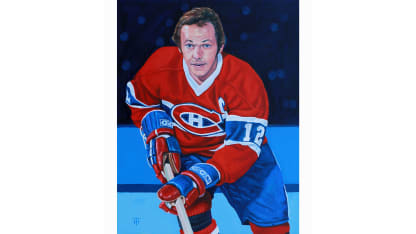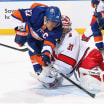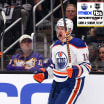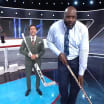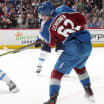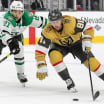As part of the NHL Centennial Celebration, renowned Canadian artist Tony Harris will paint original portraits of each of the 100 Greatest NHL Players presented by Molson Canadian as chosen by a Blue Ribbon panel. NHL.com is unveiling two portraits each day this week.
Today, the portraits of defenseman Serge Savard and forward Yvan Cournoyer are unveiled in the 49th installment.
Savard, Cournoyer portraits unveiled
Color paintings of 100 Greatest NHL Players will be revealed on NHL.com during 2017
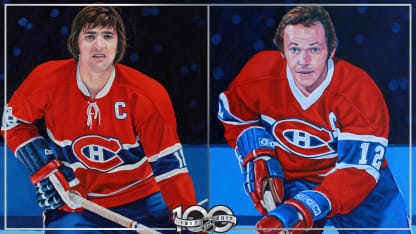
By
NHL.com @NHLdotcom
Serge Savard was one of the Montreal Canadiens' "Big Three," combining with fellow Hockey Hall of Famers Larry Robinson and Guy Lapointe to form perhaps the best trio of defensemen the NHL has ever seen. They were the cornerstone of Montreal's 1970s dynasty, helping the Canadiens win the Stanley Cup six times in nine seasons, including four in a row from 1976-79.
Though Savard came to the League as a rushing defenseman, he became more of a stay-at-home type after a series of injuries in the early 1970s cost him some speed. But he retained his mobility and became adept at using his long reach and hockey smarts to thwart attacks while still contributing offensively. Savard was in the top 10 in plus-minus rating six times in the seven seasons from 1972-73 through 1978-79. And though his offensive numbers aren't extraordinary -- 439 points (106 goals, 333 assists in 1,040 games) -- he was a member of eight Stanley Cup-winning teams and won the Conn Smythe Trophy, the first defenseman to win the playoff MVP award.
Savard retired from the Canadiens after the 1980-81 season, but was coaxed back by former teammate John Ferguson, who had taken over as general manager of the Winnipeg Jets. He played two seasons in Winnipeg before retiring for good and was inducted into the Hockey Hall of Fame in 1986.
In his
NHL100 profile of Savard
, author Stu Hackel wrote about the early stages of his career with the Canadiens:
"Serge had been a big, smooth-skating, highly skilled center as a youth. Born Jan. 22, 1946, he was raised in the Abitibi region northwest of Montreal and was discovered playing school hockey by a Canadiens scout on a tip from the owner of a general store. His size prompted the Canadiens to convert him to defense, and once he got settled playing Junior B hockey he progressed quickly, jumping to the Junior Canadiens (where he was captain and coached by [Scotty] Bowman) then to minor pro with the Houston of the Central Professional Hockey League, where he was the rookie of the year in 1967.
"He joined the big club full-time in '67-68, touted in the media as the Canadiens' answer to Bobby Orr -- though Savard would later say, 'There are stars, superstars and then there's Bobby Orr.' Coach Toe Blake also used him at forward killing penalties and, during the Canadiens' Cup championship run in '68, the rookie scored two shorthanded goals, including the only goal in Game 2 against Bowman's St. Louis Blues, who were swept by Montreal in the Final.
"Savard again elevated his play for the '69 postseason. In the Semifinals against the rival Boston Bruins, he assisted on all three Montreal goals, including the game-winner in overtime, in Game 1; scored the tying goal with 1:09 left in the third period of Game 2 and assisted on the winner in OT; and scored a third-period, tying goal in the series-clinching victory in Game 6. He outscored Orr in that series -- three goals and four assists to Orr's one goal and three assists -- in their only head-to-head playoff matchup.
"The first defenseman to win the Conn Smythe Award as playoff MVP, he had four goals and six assists in 14 games in '69 and as a penalty-killer was only on the ice for two goals-against.
"His marvelous skating and uncanny sense of anticipation allowed him to regularly hold the puck at the offensive blue line, then spin away from an oncoming winger at the last instant, showing him nothing but the No. 18 on his back, and creating a scoring chance. Eloquent Canadiens broadcaster Danny Gallivan called it the 'Savardian Spin-o-rama,' and that term became part of the hockey lexicon."
For artist Tony Harris, painting Savard was a step back in time.
"For an artist, every painting has an aspect or area that is, simply put, fun to paint," he said. "While painting Serge Savard's portrait it was his hair that made me smile. I loved capturing his 1970s long hair and mutton chop sideburns."
Yvan Cournoyer's nickname said it all.
Cournoyer, a longtime teammate of Savard with the Canadiens, was the NHL's "Roadrunner." Like the Looney Tunes character he was named after, Cournoyer blew past opposing checkers. Give him a step and he was gone, leaving a defender in his wake as he raced in alone on the goaltender.
Cournoyer scored 25 or more goals for 11 consecutive seasons and had 40 or more four times. Like his mentor and Canadiens teammate Jean Beliveau, he finished his NHL career a member of 10 Stanley Cup-winning teams.
That blazing speed helped Cournoyer overcome a lack of height. At 5-foot-7, he was always told he was too small to play hockey, but he used that as an incentive to succeed.
The talent-rich Canadiens eased Cournoyer into the lineup during the mid-1960s, using him largely as a power-play specialist. But by 1967, he was a regular, playing mostly on a line with Beliveau and John Ferguson. From 1968-69 through 1973-74, he averaged 39 goals a season while proving he was plenty tough enough to stand up to bigger players who tried to use their muscle to combat his speed.
Cournoyer was one of the heroes in Canada's victory against the Soviet Union in the 1972 Summit Series, scoring the tying goal in the final game and starting the sequence that led to Paul Henderson's game-winner. He was voted unanimously by the players to be captain of the Canadiens after Henri Richard retired in 1975, and received the Stanley Cup from NHL President Clarence Campbell the following spring after Montreal swept the Philadelphia Flyers in the Final.
Back problems reduced his effectiveness in the next three seasons and he reluctantly retired after Montreal's fourth straight championship in 1979, no doubt much to the relief of opposing checkers. His No. 12 banner hangs from the rafters at Bell Centre.
In his
NHL100 profile of Cournoyer
, Hackel wrote about his beginnings in hockey and the determination that helped him overcome his lack of size:
"Cournoyer's race to 428 goals and 435 assists in the NHL -- plus another 64 goals and 63 assists in the playoffs -- began with his first pair of skates when he was 7 years old back home in Drummondville, Quebec, also Beliveau's hometown. He loved playing hockey so much that he snagged a job at the local rink to get more ice time and would build up his leg muscles by shoveling snow off the ice sheets around town.
"He also found ways to strengthen his arms and wrists. His father was a machinist and gave his son steel pucks to shoot in the basement, which made the rubber ones on the rink feel weightless by comparison. As a teenager, he trained to be a machinist too, just in case his dream of a hockey career didn't come true. 'I cut 10 steel pucks of different weight, 10, 12, 14 ounces, up to maybe one pound,' he told Patrick Kennedy of The Kingston Whig-Standard. 'I practiced every day, shooting 10 pucks left-handed, 10 right-handed.'
"By the time he was 18 and playing junior hockey in Montreal, his legs grew so muscular that he needed specially made hockey pants to fit over his massive thighs. In his final junior season, at age 20, he scored 63 goals and 111 points. That same season, 1963-64, the Canadiens called him up for a five-game amateur tryout, and he scored four goals.
"Still, Cournoyer was rather short. He was only 5-foot-3 when he was 15 and topped top out at 5-foot-7. That posed some problems. 'People were always telling me I was too small,' he said to author Lew Freedman for the book 'Original Six.' 'But I like the fact that I'm not big. It was always a thrill for me when someone would criticize my size. It was like a good fight to make it to the top. As a youngster, I remember a coach telling me I looked too small to play on his team. All I said to him was, 'Try me.'"
Cournoyer's speed even presented some difficulties for Harris.
"I was pleased with the image that I used for Yvan Cournoyer's portrait, but it took a while to find it," he said. "There were numerous action shots of him, but many were not quite in focus. I attribute this to the photographic technology of that time having not caught up to Yvan's blinding speed on the ice."
Serge Savard
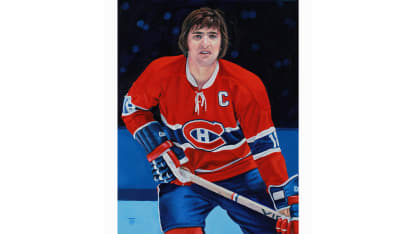
Yvan Cournoyer
